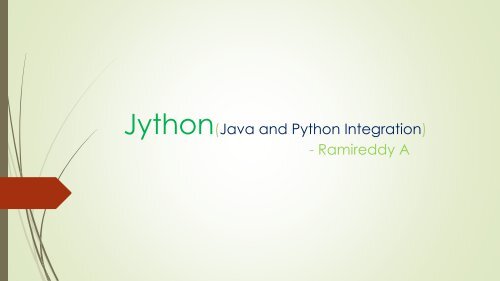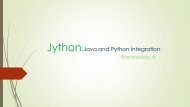Jython(Java and Python Intergration)
Create successful ePaper yourself
Turn your PDF publications into a flip-book with our unique Google optimized e-Paper software.
<strong>Jython</strong>(<strong>Java</strong> <strong>and</strong> <strong>Python</strong> Integration)<br />
- Ramireddy A
Ramireddy A<br />
Introduction :<br />
‣ <strong>Jython</strong> is the JVM implementation of the <strong>Python</strong> programming language. It is designed to<br />
run on the <strong>Java</strong> platform.<br />
‣ <strong>Jython</strong> was created in 1997 by Jim Hugunin<br />
‣ <strong>Jython</strong> 2.7.0 was released in May 2015<br />
‣ <strong>Jython</strong> jar file : https://jar-download.com/artifacts/org.python/jython-st<strong>and</strong>alone/2.7.1
Difference between <strong>Python</strong> <strong>and</strong> <strong>Java</strong>:<br />
Ramireddy A<br />
<strong>Python</strong> is a dynamically typed language. Hence, the type declaration of variable is<br />
not needed. <strong>Java</strong> on the other h<strong>and</strong> is a statically typed language, which means<br />
that the type declaration of variable is m<strong>and</strong>atory <strong>and</strong> cannot be changed.<br />
<strong>Python</strong> has only unchecked exceptions, whereas <strong>Java</strong> has both checked <strong>and</strong><br />
unchecked exceptions.<br />
<strong>Python</strong> uses indents for scoping, while <strong>Java</strong> uses matching curly brackets.<br />
Since <strong>Python</strong> is an interpreter-based language, it has no separate compilation steps.<br />
A <strong>Java</strong> program however needs to be compiled to bytecode <strong>and</strong> is in turn executed<br />
by a JVM.<br />
<strong>Python</strong> supports multiple inheritance, but in <strong>Java</strong>, multiple inheritance is not possible.<br />
It however has implementation of an interface.<br />
Compared to <strong>Java</strong>, <strong>Python</strong> has a richer built-in data structures (lists, dicts, tuples,<br />
everything is an object).
Difference between <strong>Python</strong> <strong>and</strong> <strong>Jython</strong><br />
Reference implementation of <strong>Python</strong>, called C<strong>Python</strong>, is written in C language.<br />
<strong>Jython</strong> on the other h<strong>and</strong> is completely written in <strong>Java</strong> <strong>and</strong> is a JVM implementation.<br />
St<strong>and</strong>ard <strong>Python</strong> is available on multiple platforms. <strong>Jython</strong> is available for any<br />
platform with a JVM installed on it.<br />
St<strong>and</strong>ard <strong>Python</strong> code compiles to a .pyc file, while <strong>Jython</strong> program compiles to<br />
a .classfile.<br />
<strong>Python</strong> extensions can be written in C language. Extensions for <strong>Jython</strong> are written in<br />
<strong>Java</strong>.<br />
<strong>Jython</strong> is truly multi-threaded in nature. <strong>Python</strong> however uses the Global Interpreter<br />
Lock (GIL) mechanism for the purpose.<br />
Both implementations have different garbage collection mechanisms.<br />
Ramireddy A
How to Install <strong>Jython</strong>:<br />
Ramireddy A<br />
Software link : https://www.jython.org/downloads.html<br />
Syntax : java -jar jython_installer-2.7.0.jar
<strong>Python</strong>Interpreter :<br />
Ramireddy A<br />
‣ Download jython-st<strong>and</strong>alone-2.7.0.jar - For embedding <strong>Jython</strong> in <strong>Java</strong> applications<br />
from their official downloads page: http://www.jython.org/downloads.html <strong>and</strong> include<br />
this jar file in <strong>Java</strong> CLASSPATH environment variable.<br />
‣ This library contains the <strong>Python</strong>Interpreter class.<br />
‣ Using the object of this class, any <strong>Python</strong> script can be executed using<br />
the execfile() method. The <strong>Python</strong>Interpreter enables you to make use<br />
of PyObjects directly.
<strong>Python</strong> Interpreter methods :<br />
Ramireddy A<br />
1. setIn(PyObject) 2. setIn(java.io.Reader)<br />
3. setIn(java.io.InputStream) 4. setOut(PyObject)<br />
5. setOut(java.io.Writer) 6. setOut(java,io.OutputStream)<br />
7. setErr(PyObject) 8. setErr(java.io.Writer<br />
9. setErr(java.io.OutputStream) 10. eval(String)<br />
11. eval(PyObject) 12. exec(String)<br />
13. exec(PyObject) 14. execfile(String filename)<br />
15. execfile(java.io.InputStream) 16. compile(String)<br />
17. compile(script, filename) 18.set(String name, Object value)<br />
19. set(String name, PyObject value) 20. get(String)<br />
21. get(String name, Classjavaclass)
Project Directory:<br />
Ramireddy A
Sample – 1:<br />
Ramireddy A<br />
<strong>Java</strong> Program<br />
<strong>Python</strong> file
<strong>Java</strong> Program<br />
Sample – 2 :<br />
<strong>Python</strong> file<br />
Ramireddy A
Thank Q<br />
Ramireddy A




